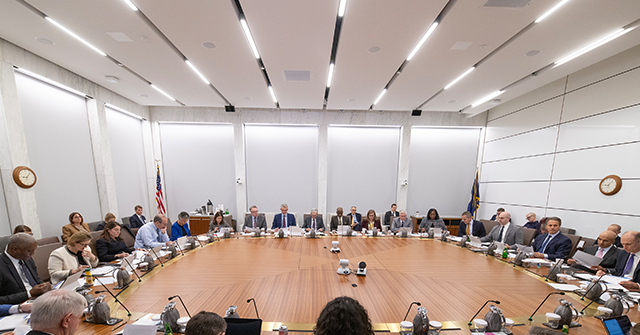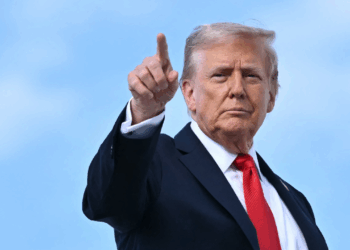The Fed’s Fault Lines: Tariffs, Labor, and the Battle Over the Next Cut
Yesterday we explored how the battle over rate cuts has scrambled old alliances inside the Federal Reserve. Today we look closer at what’s driving that split and what it means for markets.
The fault lines no longer run neatly between “hawks” and “doves,” or even between Republican and Democratic appointees. Instead, they cut across both camps, forming unlikely coalitions around two questions: Are tariffs creating durable and significant inflation risks? And is the labor market showing hidden weakness or still running strong?
These are not academic disputes. They will decide whether the Fed cuts again in December—or whether Powell’s next move is to hit pause. What follows is a look inside this strange new alignment and why even the data itself may not settle the fight.
The seven members of the Federal Reserve Board of Governors and 12 Reserve Bank presidents attend the Federal Open Market Committee (FOMC) meeting on October 28, 2025. (Federal Reserve via Flickr)
The Strange New Division at the Fed
Several forces are shaping these coalitions. First, there’s a fundamental disagreement about the nature of current inflation. The dovish camp believes tariff-driven price increases are temporary and should be ”looked through,” much as central banks traditionally ignore oil price shocks. The hawks see something more persistent—inflation that’s been above target for years and shows worrying signs of becoming entrenched. What’s more, many of the hawks brought with them to the Fed a deeply held belief that tariffs are a destructive economic policy, priming them to embrace interpretations in which import duties raise prices.
The inflation data so far appears to favor the dovish interpretation. While headline inflation remains elevated at three percent, the cooling in manufacturing price pressures and the attribution of remaining inflation primarily to tariffs suggests the price increases may indeed prove temporary once supply chains adjust. The consumer price index for core goods is up just 1.5 percent. Exclude used cars, and the core goods index is up just 1.1 percent from a year ago. Durable goods price are up just 1.8 percent. Clothing prices are down a tenth of a percentage point. New cars and trucks are up just 0.8 percent. It’s hard to see a lot of tariff pressure in these prices.
Second, Fed officials are reading labor market signals differently. Lisa Cook points to rising unemployment among vulnerable populations—youth and Black workers—and growing financial stress among low- and middle-income households. She calls this a ”two-speed economy” where the affluent thrive while others struggle. Michelle Bowman notes the employment-to-population ratio has dropped significantly, suggesting more weakness than headline unemployment numbers reveal.
Manufacturing data lends credence to these concerns. One ISM respondent from the chemical products sector captured the prevailing mood: ”Business continues to remain difficult, as customers are canceling and reducing orders due to uncertainty in the global economic environment and regarding the ever-changing tariff landscape.” The ISM report found that 58 percent of the manufacturing sector’s GDP contracted in October.
The hawks counter that labor markets remain near full employment by historical standards. They worry that keeping policy too loose risks reigniting inflation without meaningfully helping employment. What’s more, they can point to an economy that appears to be growing quite rapidly, with the Atlanta Fed’s GDPNow measure currently clocking in a four percent.
December’s High-Stakes Meeting
The plunging market odds for a December cut reflect genuine uncertainty about which faction will prevail. Just last week, with inflation data cooperating and the October cut widely anticipated, traders were near-certain the Fed would cut again next month. But as soon as the meeting concluded—with Fed Chair Jerome Powell’s cautious language, Jeffrey Schmid’s dissent to hold, and Stephen Miran’s dissent to cut more—that confidence evaporated.

The economic data between now and December will be decisive. But we still do not know what economic data will be available due to the government shutdown.
This realignment extends beyond monetary policy. It reflects a fundamental shift in how economic policy coalitions are forming across the political spectrum. The old battles between Keynesians and monetarists, between inflation fighters and full employment advocates, are giving way to new fault lines.
For now, markets are hedging their bets. At 65 percent, December remains more likely than not to bring another cut. But that’s a far cry from the near-certainty of a week ago. In a central bank as divided as this one, even the most basic near-term policy decisions have become genuinely contested.
The incoming data may ultimately vindicate one camp or the other. If inflation continues to moderate while labor markets weaken—as recent manufacturing surveys suggest—the doves will have been proven right. If inflation proves stickier than expected, the hawks’ caution will look prescient.
One thing is certain: The December meeting will test whether this divided Fed can navigate between equally unpalatable risks. And unlike past eras, we can no longer predict how officials will vote based on who appointed them.
In the new Fed, strange bedfellows make strange monetary policy—and increasingly uncertain outcomes.


















